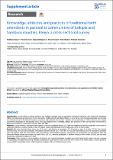| dc.contributor.author | Reeve, Matthew | |
| dc.contributor.author | Onyo, Pamela | |
| dc.contributor.author | Nyagero, Josephat | |
| dc.contributor.author | Morgan, Alison | |
| dc.contributor.author | Nduba, John | |
| dc.contributor.author | Kermode, Michelle | |
| dc.date.accessioned | 2021-08-24T20:15:52Z | |
| dc.date.available | 2021-08-24T20:15:52Z | |
| dc.date.issued | 11/26/2016 | |
| dc.identifier.citation | The Pan African Medical Journal. 2016;25 (Supp 2):13 | en_US |
| dc.identifier.issn | 1937-8688 | |
| dc.identifier.uri | http://repository.amref.org/handle/123456789/135 | |
| dc.description | © Matthew Reeve et al. The Pan African Medical Journal - ISSN 1937-8688. This is an Open Access article distributed under the terms of the Creative Commons Attribution License (http://creativecommons.org/licenses/by/2.0), which permits unrestricted use, distribution, and reproduction in any medium, provided the original work
is properly cited. | en_US |
| dc.description.abstract | Introduction: current efforts to reduce maternal and newborn mortality focus on promoting institutional deliveries with skilled birth attendants
(SBAs), and discouraging deliveries at home attended by traditional birth attendants (TBAs). In rural Kenya, semi-nomadic pastoralist communities
are underserved by the formal health system, experience high maternal and neonatal mortality, and rely primarily on TBAs for delivery care, despite
Government proscription of TBA-assisted births. This study examined the knowledge, attitude and practices of TBAs serving these communities to
assess the potential for collaboration between TBAs and SBAs.
Methods: a cross-sectional, interviewer-administered survey was conducted among 171 TBAs from Maasai and Samburu pastoralist communities in
Laikipia and Samburu counties, Kenya, as part of a larger mixed-methods study in partnership with a local service provider.
Results: BAs were relatively elderly (mean age 59.6 years), and attended an average of 5-6 deliveries per year. A minority (22.2%) had received
formal training. They provided antenatal, intra-partum and post-partum care. Most TBA care was non-interventionist, but not necessarily consistent
with best practice. Most had encountered birth complications, but knowledge regarding management of complications was sub-optimal. Most had
previously referred at least one woman to a health facility (80.1%), were key participants in decision making to refer women (96.5%), and had been
present at an institutional delivery (54.4%).
Conclusion: TBAs continue to be key providers of maternal and neonatal healthcare in regions where the formal health system has poor coverage
or acceptability. Strengthening existing TBA/SBA collaborations could improve both community links to the formal health system, and the quality of
care provided to pastoralist women, while remaining consistent with current Government policy. | en_US |
| dc.description.sponsorship | African Medical Research Foundation | en_US |
| dc.language.iso | en | en_US |
| dc.publisher | Pan African Medical Journal | en_US |
| dc.relation.ispartofseries | Strengthening health systems in communities: the experiences of AMREF Health Africa;Supp. 2: 13 | |
| dc.subject | Maternal and child health | en_US |
| dc.subject | Skilled birth attendants | en_US |
| dc.subject | Traditional birth attendants | en_US |
| dc.subject | Health systems | en_US |
| dc.subject | Pastoralist communities | en_US |
| dc.subject | Kenya | en_US |
| dc.title | Knowledge, Attitudes and Practices of Traditional Birth Attendants in Pastoralist Communities of Laikipia and Samburu Counties, Kenya: a Cross-sectional Survey | en_US |
| dc.type | Article, Journal | en_US |

